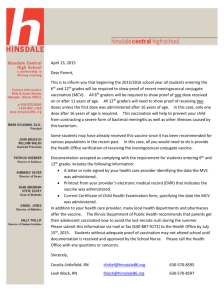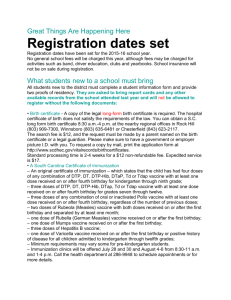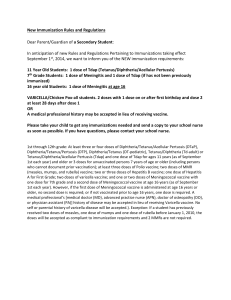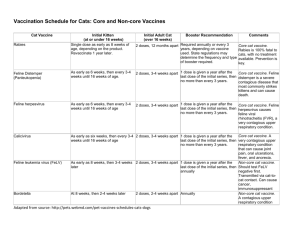Recommended Immunization Schedule for
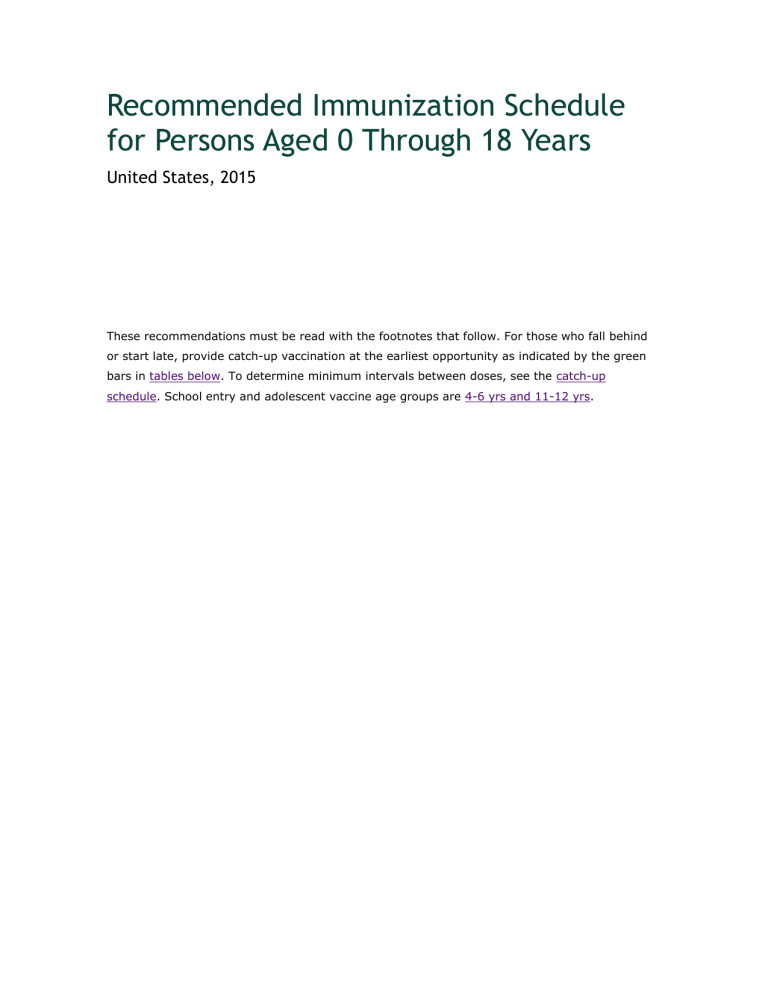
Recommended Immunization Schedule for Persons Aged 0 Through 18 Years
United States, 2015
These recommendations must be read with the footnotes that follow. For those who fall behind or start late, provide catch-up vaccination at the earliest opportunity as indicated by the green bars in tables below . To determine minimum intervals between doses, see the catch-up schedule . School entry and adolescent vaccine age groups are 4-6 yrs and 11-12 yrs .
Birth to 15 Months
Vaccine
Hepatitis B 1 (HepB)
Birth
← 1 st dose
→
1 m o
2 mos
← 2 nd dose →
Rotavirus 2 (RV)
RV1 (2-dose series);
RV5 (3-dose series)
Diphtheria, tetanus, & acellular pertussis 3 (DTaP: <7 yrs)
Tetanus, diphtheria, & acellular pertussis 4 (Tdap: ≥7 yrs)
4 mos 6 mos
9 mo s
12 mo s
15 mos
← 3 rd dose →
← 1 st dose
→
← 2 nd dose
→
See footnot e 2
← 1 st dose
→
← 2 nd dose
→
← 3 rd dose →
← 4 th dose
→
Haemophilus
influenzae type b 5 (Hib)
Pneumococcal conjugate 6 (PCV13)
Pneumococcal polysaccharide 6 (PPSV2
3)
Inactivated poliovirus 7 (IPV:<18 yrs)
Influenza 8 (IIV; LAIV)
2 doses for some: See footnote 8
← 1 st dose
→
← 2 nd dose
→
See footnot e 5
← 1 st dose
→
← 2 nd dose
→
← 3 rd dose →
← 1 st dose
→
← 2 nd dose
→
← 3 rd or
4 th dose,
See footnote
5 →
← 4 th dose →
← 3 rd dose →
Annual vaccination (IIV only) 1 or 2 doses
Measles, mumps, rubella 9 (MMR)
Varicella 10 (VAR)
Hepatitis A 11 (HepA)
See footnote 9 ← 1 st dose →
← 1 st dose →
← 2 dose series,
See footnote
11 →
Human papillomavirus 12 (HPV2: females only; HPV4: males and females)
Meningococcal 13 (Hib-
Men-CY ≥ 6 weeks;
MenACWY-D ≥9 mos;
MenACWY-CRM ≥ 2 mos)
See footnote 13
Range of recommended ages for all children
Range of recommended ages for catch-up immunization
18 Months to 18 Years
Range of recommended ages for certain high-risk groups
Range of recommended ages during which catchup is encouraged and for certain high-risk groups
Not routinely recommended
Vaccines 18 mos
Hepatitis B 1 (HepB)
Rotavirus 2 (RV)
RV1 (2-dose series); RV5
(3-dose series)
← 3 rd dose →
19-
23 mos
2-
3 yrs
4-6 yrs
7-
8 yrs
9-
10 yrs
11-12 yrs
13-
15 yrs
16-18 yrs
Diphtheria, tetanus, & acellular pertussis 3 (DTaP: <7 yrs)
Tetanus, diphtheria, & acellular pertussis 4 (Tdap: ≥7 yrs)
Haemophilus
influenzaetype b 5 (Hib)
Pneumococcal conjugate 6 (PCV13)
← 4 th dose → ← 5 th dose →
Pneumococcal polysaccharide 6 (PPSV23)
Inactivated poliovirus 7 (IPV)(<18 yrs)
← 3 rd dose →
Influenza 8 (IIV; LAIV) 2 doses for some: See footnote 8
← 4 th dose →
Annual vaccination (IIV only) 1 or 2 doses
Annual vaccination
(LAIV or IIV) 1 or 2 doses
Measles, mumps, rubella 9 (MMR)
Varicella 10 (VAR)
Hepatitis A 11 (HepA)
← 2 dose series,
See footnote
11 →
←
←
2
2 nd nd dose dose
→
→
(Tdap)
Annual vaccination (LAIV or IIV) 1 dose only
Human papillomavirus 12 (HPV2: females only; HPV4: males and females)
← (3 dose series) →
Meningococcal 13 (Hib-
Men-CY ≥ 6 weeks;
MenACWY-D ≥9 mos;
MenACWY-CRM ≥ 2 mos)
See footnote 13 ← 1 st dose → Booster
Note: The above recommendations must be read along with the footnotes of this schedule.
Footnotes
Recommended Immunization Schedule for Persons Age 0 Through 18 Years
United States, 2015
For further guidance on the use of the vaccines mentioned below, see the ACIP
Recommendations .
For vaccine recommendations for persons 19 years of age and older, see the adult immunization schedule .
1.
Hepatitis B (HepB) vaccine. (Minimum age: birth)
Routine vaccination:
At birth:
Administer monovalent HepB vaccine to all newborns before hospital discharge.
For infants born to hepatitis B surface antigen (HBsAg)-positive mothers, administer HepB vaccine and 0.5 mL of hepatitis B immune globulin (HBIG) within 12 hours of birth. These infants should be tested for HBsAg and antibody to HBsAg (anti-HBs) 1 to 2 months after completion of the HepB series at age 9 through 18 months (preferably at the next wellchild visit).
If mother's HBsAg status is unknown, within 12 hours of birth administer HepB vaccine regardless of birth weight. For infants weighing less than 2,000 grams, administer HBIG in addition to HepB vaccine within 12 hours of birth. Determine mother’s HBsAg status as soon as possible and, if mother is HBsAg-positive, also administer HBIG for infants weighing 2,000 grams or more as soon as possible, but no later than age 7 days.
Doses following the birth dose:
The second dose should be administered at age 1 or 2 months. Monovalent HepB vaccine should be used for doses administered before age 6 weeks.
Infants who did not receive a birth dose should receive 3 doses of a HepB-containing vaccine on a schedule of 0, 1 to 2 months, and 6 months starting as soon as feasible.
See Catch-up Schedule .
Administer the second dose 1 to 2 months after the first dose (minimum interval of 4 weeks), administer the third dose at least 8 weeks after the second dose AND at least 16 weeks after the first dose. The final (third or fourth) dose in the HepB vaccine series should be administered no earlier than age 24 weeks.
Administration of a total of 4 doses of HepB vaccine is permitted when a combination vaccine containing HepB is administered after the birth dose.
Catch-up vaccination:
1.
Unvaccinated persons should complete a 3-dose series.
A 2-dose series (doses separated by at least 4 months) of adult formulation Recombivax
HB is licensed for use in children aged 11 through 15 years.
For other catch-up guidance, see Catch-up Schedule .
2.
Rotavirus (RV) vaccines. (Minimum age: 6 weeks for both RV1 [Rotarix] and RV5
[RotaTeq])
Routine vaccination:
Administer a series of RV vaccine to all infants as follows:
1.
If Rotarix is used, administer a 2-dose series at 2 and 4 months of age.
2.
If RotaTeq is used, administer a 3-dose series at ages 2, 4, and 6 months.
3.
If any dose in the series was RotaTeq or vaccine product is unknown for any dose in the series, a total of 3 doses of RV vaccine should be administered.
Catch-up vaccination:
The maximum age for the first dose in the series is 14 weeks, 6 days; vaccination should not be initiated for infants aged 15 weeks, 0 days or older.
The maximum age for the final dose in the series is 8 months, 0 days.
3.
For other catch-up guidance, see Catch-up Schedule .
Top of Page
Diphtheria and tetanus toxoids and acellular pertussis (DTaP) vaccine. (Minimum age: 6
weeks. Exception: DTaP-IPV [Kinrix]: 4 years)
Routine vaccination:
Administer a 5-dose series of DTaP vaccine at ages 2, 4, 6, 15 through 18 months, and 4 through 6 years. The fourth dose may be administered as early as age 12 months, provided at least 6 months have elapsed since the third dose. However, the fourth dose of
DTaP need not be repeated if it was administered at least 4 months after the third dose of
DTaP.
Catch-up vaccination:
The fifth dose of DTaP vaccine is not necessary if the fourth dose was administered at age
4 years or older.
For other catch-up guidance, see Catch-up Schedule .
4.
Tetanus and diphtheria toxoids and acellular pertussis (Tdap) vaccine. (Minimum age: 10 years for both Boostrix and Adacel)
Routine vaccination:
Administer 1 dose of Tdap vaccine to all adolescents aged 11 through 12 years.
Tdap may be administered regardless of the interval since the last tetanus and diphtheria toxoid-containing vaccine.
Administer 1 dose of Tdap vaccine to pregnant adolescents during each pregnancy (preferred during 27 through 36 weeks' gestation) regardless of time since prior Td or Tdap vaccination.
Catch-up vaccination:
Persons aged 7 years and older who are not fully immunized with DTaP vaccine should receive
Tdap vaccine as 1 dose (preferably the first) in the catch-up series; if additional doses are needed, use Td vaccine. For children 7 through 10 years who receive a dose of Tdap as part of the catch-up series, an adolescent Tdap vaccine dose at age 11 through 12 years should NOT be administered. Td should be administered instead 10 years after the Tdap dose.
Persons aged 11 through 18 years who have not received Tdap vaccine should receive a dose followed by tetanus and diphtheria toxoid (Td) booster doses every 10 years thereafter.
Inadvertent doses of DTaP vaccine: o If administered inadvertently to a child aged 7 through 10 years may count as part of the catch-up series. This dose may count as the adolescent Tdap dose, or the child can later receive a Tdap booster dose at age 11 through 12 years. o If administered inadvertently to an adolescent aged 11 through 18 years, the dose should be counted as the adolescent Tdap booster.
For other catch-up guidance, see Catch-up Schedule .
